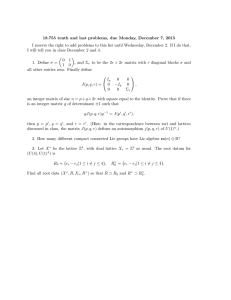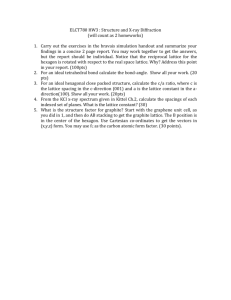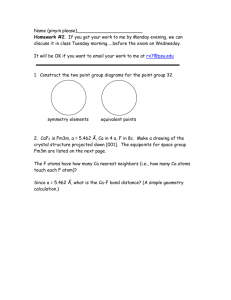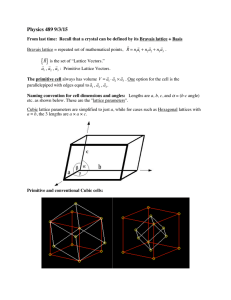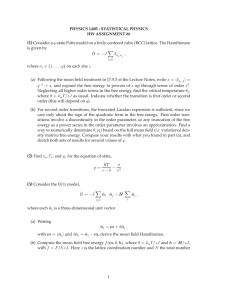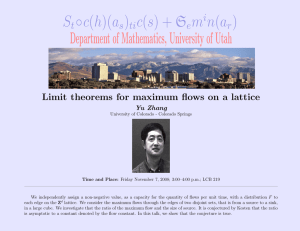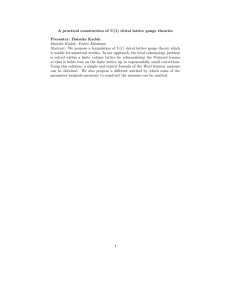Ground states and formal duality relations in the Gaussian core model
advertisement
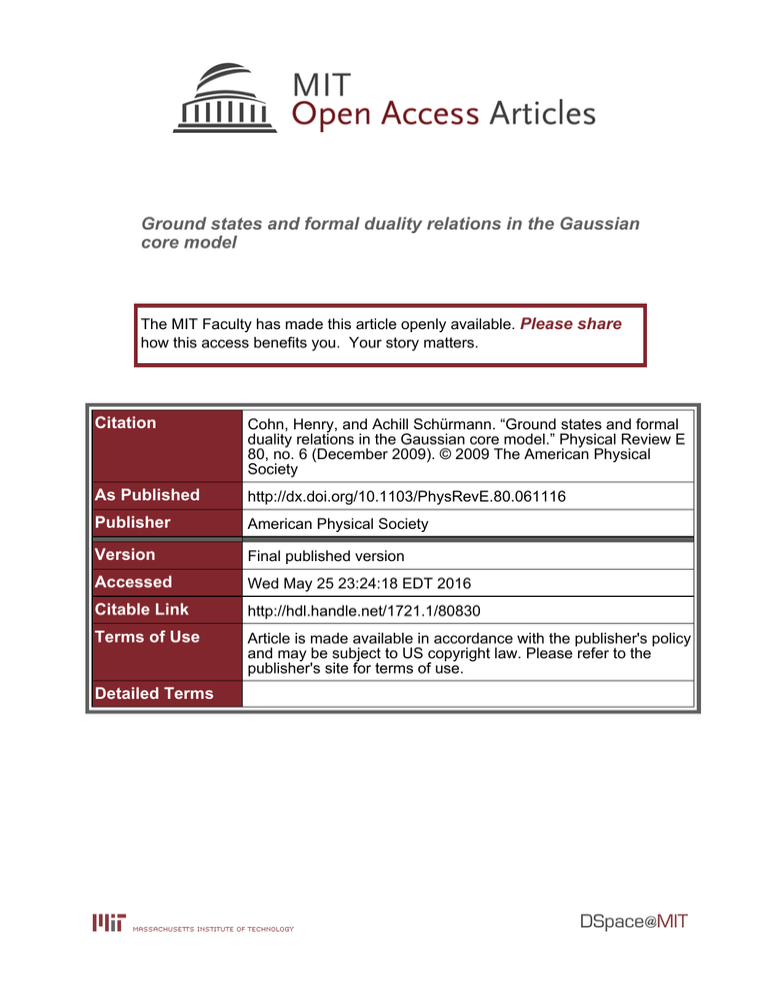
Ground states and formal duality relations in the Gaussian core model The MIT Faculty has made this article openly available. Please share how this access benefits you. Your story matters. Citation Cohn, Henry, and Achill Schürmann. “Ground states and formal duality relations in the Gaussian core model.” Physical Review E 80, no. 6 (December 2009). © 2009 The American Physical Society As Published http://dx.doi.org/10.1103/PhysRevE.80.061116 Publisher American Physical Society Version Final published version Accessed Wed May 25 23:24:18 EDT 2016 Citable Link http://hdl.handle.net/1721.1/80830 Terms of Use Article is made available in accordance with the publisher's policy and may be subject to US copyright law. Please refer to the publisher's site for terms of use. Detailed Terms PHYSICAL REVIEW E 80, 061116 共2009兲 Ground states and formal duality relations in the Gaussian core model Henry Cohn* Microsoft Research New England, One Memorial Drive, Cambridge, Massachusetts 02142, USA Abhinav Kumar† Department of Mathematics, Massachusetts Institute of Technology, Cambridge, Massachusetts 02139, USA Achill Schürmann‡ Institute of Applied Mathematics, TU Delft, Mekelweg 4, 2628 CD Delft, The Netherlands 共Received 24 September 2009; published 14 December 2009兲 We study dimensional trends in ground states for soft-matter systems. Specifically, using a high-dimensional version of Parrinello-Rahman dynamics, we investigate the behavior of the Gaussian core model in up to eight dimensions. The results include unexpected geometric structures, with surprising anisotropy as well as formal duality relations. These duality relations suggest that the Gaussian core model possesses unexplored symmetries, and they have implications for a broad range of soft-core potentials. DOI: 10.1103/PhysRevE.80.061116 PACS number共s兲: 05.20.⫺y, 61.50.Ah I. INTRODUCTION Soft-matter systems are notoriously difficult to analyze theoretically, and much of what we know about their phase diagrams is based on numerical simulations. Even classical ground states can almost never be derived from first principles 共see Refs. 关1–5兴 for some rare exceptions兲. In this article, we place phenomena such as crystallization and solid-solid phase transitions in a broader context by studying dimensional trends in the Gaussian core model 关6兴, in which particles interact via a Gaussian pair potential. The Gaussian potential models the entropic effective interaction between the centers of mass of polymers 关7兴, and it is one of the simplest and most elegant soft-core potentials. The behavior of the Gaussian core model in two and three dimensions is relatively well understood 共see, for example, Refs. 关8,9兴兲, but in higher dimensions, it remains mysterious. Dimensions above three are an excellent test case for the study of phenomena such as decorrelation 关10兴, and this fits into the long tradition in statistical mechanics of studying the effect of dimensionality in interacting systems, such as critical dimensions for mean-field behavior 共see Section 16.7 in Ref. 关11兴 for an overview兲. Furthermore, higher dimensions play a fundamental role in information theory. Sphere packing is the low-density limiting case of the Gaussian core model, and sphere packings are error-correcting codes for a continuous communication channel. The dimension of the ambient space for the packing depends on the channel and coding method used, and it can be quite high in practice 关12兴 共up to thousands of dimensions兲. Thus, coding theory is a powerful motivation for the study of the high-dimensional Gaussian core model. Our conclusions are based on molecular dynamics simulations 关13兴. Such simulations are frequently used and often *cohn@microsoft.com † abhinav@math.mit.edu a.schurmann@tudelft.nl ‡ 1539-3755/2009/80共6兲/061116共7兲 highly informative, but the computational difficulties are immense for many-body systems. Thanks to the curse of dimensionality 关14兴, high-dimensional simulations typically require exponentially many particles, which severely limits the range of dimensions in which simulations are possible. To address this problem, we use a high-dimensional version of Parrinello-Rahman dynamics 关15,16兴. Instead of imposing periodic boundary conditions using a fixed background lattice, we dynamically update the lattice using the intrinsic geometry of the space of lattices. By increasing the adaptivity of the simulation, we are able to minimize the number of particles and avoid unnecessary computational complexity. This lets us carry out higher-dimensional simulations than were previously possible. In this article, we carry out Parrinello-Rahman simulations of the Gaussian core model in dimensions two through eight. In addition to observing surprising geometrical phenomena such as anisotropy, we find formal duality relations between Gaussian core ground states at densities and 1 / . Although such duality is known between reciprocal Bravais lattices 共see, for example, Ref. 关17兴兲, it rarely holds for other structures, and its occurrence here suggests a deeper, not yet understood symmetry of the Gaussian core model itself. Our approach fits into a program pioneered by Gottwald et al. 关18兴 and applied in Refs. 关19,20兴. They use genetic algorithms to search the space of candidate structures into which a fluid can freeze. Our goals are similar, but we make use of more analytic tools. Specifically, we compute gradients in the space of lattices, which enables us to use more powerful optimization techniques such as gradient descent or conjugate gradient. II. FRAMEWORK Consider a periodic configuration of particles in n-dimensional Euclidean space Rn. Such a configuration is specified by an underlying Bravais lattice ⌳ 傺 Rn, together with a collection of translation vectors v1 , . . . , vN. In crystallographic terms, it is a lattice with basis. The particles are 061116-1 ©2009 The American Physical Society PHYSICAL REVIEW E 80, 061116 共2009兲 COHN, KUMAR, AND SCHÜRMANN located at the points x + vi for x 苸 ⌳ and 1 ⱕ i ⱕ N. Given a radial pair potential V, the average energy per particle is N N 1 兺兺 2N i=1 j=1 兺 V共兩z + vi − v j兩兲. z苸⌳ z⫽0 if i=j This quantity is the potential energy of the system, and the configuration is a classical ground state if it minimizes potential energy, even allowing ⌳ and N to vary but keeping the particle density fixed. 关The density equals N / det共⌳兲, where det共⌳兲 is the absolute value of the determinant of a basis for ⌳.兴 In other words, classical ground states correspond to the canonical ensemble at zero temperature. Simulations typically fix ⌳ and allow v1 , . . . , vN to vary. This amounts to using ⌳ to define periodic boundary conditions. The lattice ⌳ remains the same throughout this process, and it is often chosen to be proportional to a hypercubic lattice Zn for computational simplicity. This imposes artificial structure on the system, and N must be chosen quite large to minimize the effects of this structure. For example, if one wants the lattice spacing in ⌳ to be an order of magnitude larger than the typical spacing between particles, then N must grow roughly like 10n. For large n, this is clearly infeasible, and even for n = 6, it requires careful use of all available computational improvements. Many simulations, such as those in Ref. 关21兴, are therefore limited to roughly six dimensions. By allowing ⌳ to vary, one might hope to use a much smaller value of N. In the most extreme case, one could take N = 1 and study all Bravais lattice configurations. The naive dynamics then fail completely, because the forces in a Bravais lattice balance perfectly. Nevertheless, the potential energy varies dramatically between different Bravais lattices, with corresponding dynamics on the space of lattices. The Parrinello-Rahman method uses these dynamics. It can therefore simultaneously update the underlying Bravais lattice ⌳ and the particle locations v1 , . . . , vN. Before describing the simulation results, we will give a derivation of the n-dimensional version of ParrinelloRahman dynamics. It is equivalent to the original formulation in Refs. 关15,16兴, except of course for the change in dimension. Instead of deriving it from a postulated Lagrangian, we show how it follows naturally from the intrinsic geometry of the space of lattices. Presenting the derivation gives us an opportunity to describe some of the computational issues that become important in higher dimensions, such as the use of lattice basis reduction algorithms. deforming the lattice, we will fix the lattice and deform the metric. This approach is used to define the intrinsic geometry on the space of lattices 共see, for example, Ref. 关22兴兲, and it makes the formulas quite a bit simpler. To simplify the notation, define the function f of squared distance by f共s兲 = V共冑s兲 / 2. Furthermore, write the vectors v1 , . . . , vN in the new coordinates as vi = Tui. Now the potential energy of the system is U共G兲 = 1 兺 f共wtGw兲, N w where we sum over all vectors w of the form ui − u j + x with 1 ⱕ i, j ⱕ N, x 苸 Zn, and x ⫽ 0 if i = j. The gradient of this sum as a function of G equals the matrix ⵜU共G兲 = 1 兺 f ⬘共wtGw兲wwt . N w To see why, note that if we vary the i , j component Gij of G while leaving all other entries fixed 关and write w = 共w1 , . . . , wn兲兴, we find that f共wtGw兲 = f ⬘共wtGw兲wiw j . Gij When we update the configuration, we must fix det共G兲, so that the density of the system does not change 关note that det共G兲 = det共⌳兲2兴. However, the gradient does not respect this constraint. Instead, we must use the modified gradient ˜ U共G兲 conditioned on fixing the determinant, which is comⵜ puted as follows. If we define the standard inner product 具· , ·典 on the space of symmetric matrices by 具A , B典 = tr共AB兲, then to preserve det共G兲, we must remove the component of ⵜU共G兲 in the direction of G−1, because det„G + ⵜ U共G兲… = det共G兲„1 + 具G−1,ⵜU共G兲典 + O共2兲…. ˜ U共G兲 by We define the modified gradient ⵜ −1 ˜ U共G兲 = ⵜU共G兲 − 具ⵜU共G兲,G 典 G−1 , ⵜ 具G−1,G−1典 ˜ U共G兲典 = 0. so that 具G−1 , ⵜ We could avoid this last complication by replacing the canonical ensemble with the grand canonical ensemble and controlling the particle density via the chemical potential. However, the modified gradient is not difficult to use, and our approach is convenient if one wishes to target a specific density. III. GEOMETRY OF THE SPACE OF LATTICES IV. PARRINELLO-RAHMAN DYNAMICS We will represent Bravais lattices by positive-definite, symmetric matrices. Specifically, there is a linear transformation with matrix T such that ⌳ = TZn. If v = Tw, then the squared vector length vtv 共the exponent t denotes transpose and we use column vectors兲 is wtTtTw. Set G = TtT. This Gram matrix represents the metric in coordinates in which the underlying lattice is Zn. Instead of fixing the metric and The lattice gradient has two components, one for changing G 共computed above as the modified gradient兲 and one for changing u1 , . . . , uN. For the latter, if we write w = ui − u j + x, then we need the gradient of f共wtGw兲 as a function of ui and u j, which is easily computed as follows. With w = ui − u j + x, the gradient of f共wtGw兲 as a function of ui is 2f ⬘共wtGw兲Gw. Thus, the ui component of the gradient of potential energy is 061116-2 PHYSICAL REVIEW E 80, 061116 共2009兲 GROUND STATES AND FORMAL DUALITY RELATIONS IN… the sum of 共2 / N兲f ⬘共wtGw兲Gw over all w of the form ui − u j + x for some j plus the sum of −共2 / N兲f ⬘共wtGw兲Gw over all w of the form u j − ui + x for some j. The full lattice gradient is made up of both the G and the u1 , . . . , uN components. Parrinello-Rahman dynamics consists of using the lattice gradient to define forces on the configuration. Thus, G changes as well as u1 , . . . , uN. The simplest application is gradient descent, where we seek a local minimum for energy by following the negative gradient 共or, better yet, using the conjugate gradient algorithm兲. Of course, one could also use the forces in the usual way to define accelerations rather than simply velocities, but we will focus on gradient descent here because of our interest in ground states. The infinite sums in the algorithm must be truncated in practice, by summing only over the w such that wtGw is at most some bound 共chosen based on the decay rate of f兲. Writing w = ui − u j + x, we must enumerate all x 苸 Zn with this property. To do so, we use the Fincke-Pohst algorithm 关23兴, which is far more efficient than brute-force searches. By contrast, simply summing over all the vectors in a large box becomes exponentially inefficient in high dimensions. We also periodically apply the L3 lattice basis reduction algorithm 关24兴, which changes basis so as to keep the entries of G small, and we renormalize G to maintain a constant determinant 共so that small numerical errors do not accumulate兲. As the simulation progresses, the metric changes and the connection with the original coordinates is lost. Nevertheless, using the Cholesky decomposition 关25兴, we can recover the Bravais lattice TZn with basis Tu1 , . . . , TuN from the matrix G and the vectors u1 , . . . , uN by finding T such that G = TtT. Because of the need to use tools from lattice basis reduction theory and linear algebra, the Parrinello-Rahman method is not as simple to implement in high dimensions as more straightforward methods are. However, in compensation it adapts itself to the structure of the system being considered and can therefore provide improved results. Furthermore, it is compatible with other standard computational methods such as Ewald summation or fast multipole methods 关13兴. V. RESULTS FOR THE GAUSSIAN CORE MODEL For the Gaussian core model, we take V共r兲 = exp共−r2兲 and hence f共s兲 = exp共−s兲 / 2. The choice of the constant amounts to fixing the length scale, and it is chosen to make V self-dual under the Fourier transform. Let denote the particle density. The ground states of this model have been thoroughly examined in up to three dimensions, although except in R1, no proof is known 关5兴. In R2, at all densities, the ground state is the triangular lattice A2. In R3, the face-centered cubic lattice D3 is optimal at low densities, and the reciprocal body-centered cubic lattice Dⴱ3 is optimal at high densities 关26兴. The crossover point is at = 1, but in fact the Maxwell double-tangent construction 共i.e., the convexity of potential energy as a function of 1 / 兲 leads to phase coexistence for 0.99899854. . . ⱕ ⱕ 1.00100312. . .. This appears to give a complete description of the phase transition from D3 to Dⴱ3. TABLE I. Lowest known energies in dimension n when = 1. The third column specifies the putative ground state, with “pc1” and “pc2” standing for phase coexistence between D3 and Dⴱ3 and between D+5 共1.99750. . .兲 and D+5 共0.50062. . .兲, respectively. n Energy State n Energy State 1 2 3 4 0.04321740. . . 0.07979763. . . 0.11576766. . . 0.14288224. . . Z A2 pc1 D4 5 6 7 8 0.17434205. . . 0.19437337. . . 0.21222702. . . 0.22788144. . . pc2 P6共1.0525. . .兲 D+7 E8 Little is known in higher dimensions, despite the connections with coding and information theory. Cohn and Kumar 关5兴 conjectured that the E8 and Leech lattices are universally optimal when n = 8 or 24, respectively. 共In other words, they are ground states for the Gaussian core model at all densities. As shown in Ref. 关5兴, this implies optimality for many other potentials, such as all inverse power laws.兲 Torquato and Stillinger 关17兴 conjectured that in at most eight dimensions, certain Bravais lattices are always optimal at sufficiently high or low densities, but their conjecture was disproved in five and seven dimensions 关27兴. Despite extensive exploration 关28兴, the true ground states have remained a mystery. Because of the difficulty of simulation, previous studies have made use only of structures already known for other reasons. Comparing such structures in the Gaussian core model is of course of value, and it can sometimes lead to surprising results, but it provides little evidence as to the true ground states. We have run numerous Parrinello-Rahman simulations with 2 ⱕ n ⱕ 8, 1 ⱕ N ⱕ 24 共and occasionally larger兲, and various densities, with the following results 共see also Table I兲. In two and three dimensions, we observe the previously known ground states. In four dimensions, we find the D4 lattice at all densities, in accordance with the conjecture in Ref. 关17兴. Thus, it appears probable that, like E8 and the Leech lattice, the D4 lattice is universally optimal. In five dimensions, we find different structures. The ⌳25 lattice was used in Ref. 关27兴 to improve on Bravais lattices at low density; it consists of parallel translates of D4, repeating with period 4. Parrinello-Rahman simulations rapidly identify and improve on this structure. It can be deformed by compressing the spacing between the parallel copies by some factor. A local minimum for energy is achieved for carefully optimized values of the compression factor, which are between 0.998749. . . and 1 when ⱕ 1 and between 0.25 and 0.250312. . . when ⱖ 1. Our simulations suggest that these are the true ground states, with the exception of phase coexistence for 0.99836946. . . ⱕ ⱕ 1.00163526. . .. These structures fit into the following general family. Let Dn = 兵共x1, . . . ,xn兲 苸 Zn : x1 + . . . + xn is even其 denote the checkerboard lattice in Rn, and let D+n be the union of Dn with its translation by 共1 / 2 , 1 / 2 , . . . , 1 / 2兲. Let D+n 共␣兲 be D+n with the last coordinate scaled by a factor of ␣. That is, 061116-3 PHYSICAL REVIEW E 80, 061116 共2009兲 COHN, KUMAR, AND SCHÜRMANN 冉 冉 冉 1.520 1.348 ln 12 ln 1 ln 2 FIG. 1. A plot of −1/2共2U + 1兲 as a function of ln , where U is the minimal energy attained by the structures D+5 共␣兲 at density . The reflection symmetry follows from formal duality. D+n 共␣兲 = 兵共x1, . . . ,xn−1, ␣xn兲 : 共x1, . . . ,xn兲 苸 D+n 其. Then D+5 共␣兲 is the deformation of ⌳25 with compression factor ␣ / 2. This is not obvious, but it can be checked by a straightforward computation, and in fact it gives a substantially simpler construction of ⌳25 than was previously known 关namely, as D+5 共2兲兴. One noteworthy aspect of these configurations is their anisotropy. As the density increases, they experience greater compression along a distinguished axis than orthogonally to it. However, an even more surprising phenomenon is that there are formal duality relationships between these structures. Formal duality is a generalization of the relationship between a Bravais lattice and its reciprocal lattice 共see Sec. VI for more details兲. Formal duality relates the energies at densities and 1 / : if E is the Gaussian core energy at density for a given structure and Ẽ is that for its formal dual, then 2E + 1 2Ẽ1/ + 1 = . More generally, formal duality relates the energy of one structure under a given pair potential to that of the formally dual structure under the Fourier transform of the potential. A non-Bravais lattice typically has no formal dual. Thus, it is remarkable that D+n 共␣兲 is formally dual to D+n 共1 / ␣兲. 共See Sec. VI for a proof.兲 Formal duality implies that the highdensity ground states in R5 tend to D+5 共1 / 2兲, because the low-density ones tend to D+5 共2兲 = ⌳25. Figure 1 illustrates the formal dualities within the D+5 共␣兲 family of structures. In six dimensions, the lowest-energy states previously known were the Bravais lattice E6 for low density and its reciprocal lattice Eⴱ6 for high density, with a narrow region of phase coexistence in between. The lattices remain the lowest-energy states known at extreme densities, but in between them, our simulations have identified other candidate ground states. They are all deformations of the orthogonal direct sum D3 丣 D3, together with its translates by three vectors, namely, 冊 1 1 1 1 1 1 , , , , , , 2 2 2 2 2 2 冊 冊 1 1 1 1,1,1,− ,− ,− , and 2 2 2 1 1 1 − ,− ,− ,1,1,1 . 2 2 2 共These vectors are made up of holes in D3.兲 Define P6共␣兲 to be the structure obtained by scaling the first three coordinates by a factor of ␣ and the last three by 1 / ␣, so that volume is preserved. For certain values of ␣, these structures improve on E6 and Eⴱ6 for 0.25384516. . . ⱕ ⱕ 3.93940925. . ., with phase coexistence for 3.93255017. . . ⱕ ⱕ 3.94624440. . . and for the reciprocal range of densities. Unlike D+5 共␣兲, which can be viewed as a modification of D+5 or ⌳25, the structures P6共␣兲 differ more substantially from previously analyzed structures. As in five dimensions, however, there are formal duality relations. Specifically, P6共␣兲 is formally dual to P6共1 / ␣兲 for each ␣ 关of course P6共1 / ␣兲 is isometric to P6共␣兲兴. In seven dimensions, we find the D+7 共␣兲 family of structures at all densities. For 0.04660088. . . ⱕ ⱕ 21.45881937. . ., the ground state seems to be D+7 itself 共i.e., ␣ = 1兲. For lower densities, we have ␣ ⬎ 1 and for higher densities we have ␣ ⬍ 1. Unlike the case of R5, there is no phase coexistence, because the optimal value of ␣ changes continuously as a function of density. The lowdensity limit of D+7 共␣兲 is D+7 共冑2兲, which is the same as the ⌳37 structure studied in Ref. 关27兴. By formal duality, the highdensity limit is D+7 共1 / 冑2兲. Finally, in eight dimensions our simulations provide further evidence that E8 共i.e., D+8 兲 is universally optimal. Parrinello-Rahman simulations are by no means limited to eight dimensions, and in fact, we have numerical results in as many as twelve dimensions. These results, together with a more extensive analysis of the structures presented here, will appear elsewhere 关29兴. Within the D+n 共␣兲 family of structures for 1 ⱕ n ⱕ 8, the best energy at low density 共i.e., the best sphere packing兲 is obtained when ␣ = 冑9 − n. For n ⱕ 4, the D+n 共冑9 − n兲 configuration is inferior to previously known sphere packings. However, for 5 ⱕ n ⱕ 8 it achieves the highest sphere packing density currently known. Note that D+6 共冑3兲 is the ⌳26 packing, which has the same packing density as E6 but is slightly inferior in the Gaussian core model at low densities. We have no conceptual explanation for why the six-dimensional behavior is subtly different from that in five, seven, or eight dimensions. It is also interesting to examine the ␣ = 1 case. It seems that the D+5 and D+6 structures are not local optima for the Gaussian core model at any density. By contrast, D+7 appears to be the ground state over a large range of densities, and D+8 is almost certainly the ground state at all densities. It is possible that D+9 is also universally optimal: so far we have not explored this case as thoroughly as those in lower dimensions, but we have not yet found any structure that beats D+9 at any density. We will examine this issue elsewhere 关29兴. 061116-4 PHYSICAL REVIEW E 80, 061116 共2009兲 GROUND STATES AND FORMAL DUALITY RELATIONS IN… Universal optimality cannot hold for D+n with n ⱖ 10, because these packings are not even optimal sphere packings. Poisson summation formula: for a Bravais lattice ⌳ and translation vector v, 1 兺 f共x + v兲 = vol共Rn/⌳兲 兺 x苸⌳ VI. FORMAL DUALITY Recall that Poisson summation relates the sum of a function over a Bravais lattice to the sum of its Fourier transform over the reciprocal lattice. Specifically, given a sufficiently well-behaved function f : Rn → R 共for example, a Schwartz function兲 and a Bravais lattice ⌳ 傺 Rn, y苸⌳ⴱ 共In fact, the right side is the Fourier expansion of the left side as a function of v that is periodic modulo ⌳.兲 The average pair sum of f over ⌳ + v1 , . . . , ⌳ + vN then becomes 冏 Here, vol共Rn / ⌳兲 denotes the volume of a fundamental domain of ⌳ and we normalize the Fourier transform and reciprocal lattice by 冕 f共x兲e2i具x,y典dx Rn and ⌳ⴱ = 兵y 苸 Rn : 具x,y典 苸 Z for all x 苸 ⌳其. Formal duality is a generalization of Poisson summation to certain special structures that are not Bravais lattices. To state it correctly, it is important to view the sum 兺 f共x兲 x苸⌳ not simply as a sum over points in ⌳, but rather as a sum over vectors between points in ⌳. For a Bravais lattice these notions are exactly the same, but in more general cases they are not. 共In fact, Poisson summation cannot be generalized from the first point of view 关30兴.兲 For example, consider a periodic configuration given by the union of N disjoint lattice translates ⌳ + v1 , . . . , ⌳ + vN. Then the analog of summing over the lattice is N N 1 N e2i具v j,y典 兺 f̂共y兲 N 兺 vol共Rn/⌳兲 y苸⌳ⴱ j=1 1 f共x兲 = 兺 兺 f̂共y兲. vol共Rn/⌳兲 y苸⌳ⴱ x苸⌳ f̂共y兲 = e−2i具v,y典 f̂共y兲. N 1 兺 兺 兺 f共x + v j − vk兲. N j=1 k=1 x苸⌳ Call this sum the average pair sum of f over the configuration. It is the average over all points in the configuration of the sum of f over all vectors from it to other points. 共Thus, it is independent of how the configuration is decomposed into translates of Bravais lattices.兲 Suppose P and Q are particle arrangements, where P has particle density ␦ and Q has particle density 1 / ␦. We say P and Q are formal duals if for every Schwartz function f, the average pair sum of f over P is ␦ times that for f̂ over Q. Poisson summation shows that this definition generalizes the case of reciprocal Bravais lattices. If P is formally dual to itself, we call it formally self-dual, and if it is formally dual to an isometric copy of itself, we call it formally isodual. For example, the triangular lattice in the plane is not self-dual, since its reciprocal lattice is a rotated copy of itself, but it is isodual. For any periodic configuration, one can always write the average pair sum of f in terms of f̂, by using a generalized 冏 2 . The factor of N / vol共Rn / ⌳兲 is the density of the configuration, so the question becomes whether the remaining sum is the average pair sum of f̂ over some periodic structure. Except when N = 1, it usually is not: for example, the coefficient of f̂共y兲 is generally irrational. Formal duality only arises in exceptional cases. It is not obvious when a configuration has a formal dual or, if it does have one, what the formal dual is. Proposition 1. The D+n structure is formally self-dual when n is odd or a multiple of four. When n is even but not a multiple of four, D+n is formally isodual. When n is even, D+n is a Bravais lattice, whose reciprocal lattice is D+n if n is a multiple of four and D+n 共−1兲 otherwise. When n is odd, D+n is not a Bravais lattice and the duality is more subtle. Proof. Let v = 共1 / 2 , 1 / 2 , . . . , 1 / 2兲, so D+n is the union of Dn and Dn + v. Then the average pair sum of f over D+n is 1 4 兺 y苸Dⴱn f̂共y兲兩1 + e2i具v,y典兩2 = 兺 y苸Dⴱn f̂共y兲 1 + cos共2具v,y典兲 . 2 The reciprocal lattice Dⴱn consists of four translates of Dn, by the vectors 0, v, 共0 , 0 , . . . , 0 , 1兲, and 共1 / 2 , 1 / 2 , . . . , 1 / 2 , −1 / 2兲. In each of these four cases, the inner product 具v , y典 is easily understood. In the first case, it is an integer, in the second it is an integer plus n / 4, in the third it is an integer plus 1/2, and in the fourth it is an integer plus 共n − 2兲 / 4. When n is odd, this yields weights of 1, 1/2, 0, and 1/2 multiplying f̂共y兲 in the four cases. Because n is odd, the vector 共1 , 1 , . . . , 1 , 0兲 is in Dn and hence translating Dn by 共1 / 2 , 1 / 2 , . . . , 1 / 2 , −1 / 2兲 is equivalent to translating it by −v. Thus, the average pair sum for f is simply 1 兺 „2f̂共x兲 + f̂共x + v兲 + f̂共x − v兲…, 2 x苸Dn which is the same as the average pair sum for f̂ over D+n . It follows that D+n is formally self-dual when n is odd. An analogous computation works in the even case, or it can be verified more simply using the fact that D+n is then a Bravais lattice. 䊏 Lemma 2. If P and Q are formally dual structures in Rn, and T : Rn → Rn is an invertible linear transformation, then TP and 共Tt兲−1Q are formally dual. Here, Tt denotes the adjoint operator with respect to the inner product 共i.e., the transposed matrix兲. Proof. To compute the average pair sum for f on TP, 061116-5 PHYSICAL REVIEW E 80, 061116 共2009兲 COHN, KUMAR, AND SCHÜRMANN simply compute it for the composition f ⴰ T on P. The Fourier transform of f ⴰ T is 共det T兲−1(f̂ ⴰ 共Tt兲−1). Now applying formal duality for P and Q completes the proof. 䊏 It follows immediately that D+n 共␣兲 is formally dual to D+n 共1 / ␣兲 when n is odd or a multiple of four: apply Lemma 2 with P = Q = D+n and with T being the map that multiplies the last coordinate by ␣. The formal isoduality of P6共␣兲 is proved similarly. For ␣ = 1, formal self-duality follows from a calculation much like the proof for Proposition 1. Then Lemma 2 implies that P6共␣兲 is formally dual to P6共1 / ␣兲, but of course, the two configurations are isometric. In the literature, formal duality is usually understood to refer only to radial functions f 共see, for example, p. 185 of Ref. 关31兴兲. That is a weaker condition, which depends only on the radial pair correlation functions of the structures. We have defined a stronger version of formal duality in this paper, without that restriction, because the stronger version in fact holds for the structures we find in our simulations. 共Furthermore, it behaves better. For example, the proof of Lemma 2 breaks down in the radial case, because f and f ⴰ T will generally not both be radial.兲 However, for the discussion in Sec. V, the pair potential is isotropic, so only the radial version of formal duality is needed. Note also that radial symmetry erases the distinction between formal selfduality and formal isoduality. VII. CONCLUSIONS AND DISCUSSION We have used Parrinello-Rahman dynamics to identify ground states in dimensions that were previously beyond the reach of simulation. This approach is effective because it adapts to whichever underlying Bravais lattice is most favorable. That means it probably offers little advantage in detecting disordered states or even phase coexistence, but it is appropriate whenever one anticipates a high degree of symmetry. The formal duality relations are the most noteworthy consequence of our simulations. Such relations occur only rarely for structures other than Bravais lattices, and it is far from obvious why they arise here. A remarkable possibility is that all periodic ground states of the Gaussian core model, in any dimension, may occur in formally dual pairs. If true, this hypothesis deserves a more conceptual explanation than a case-by-case calculation, and it suggests that the model possesses deeper symmetries than are currently understood. Even if it is false, there must be a reason why formal duality arises so frequently in low dimensions. The families of structures studied in this article have much broader applicability than just to the Gaussian core model. We believe that they will minimize many other repulsive potential functions, such as inverse power laws, although we have done relatively little experimentation in this direction. One reason for our focus on the Gaussian core model is that it is the natural setting for studying universal optimality 关5兴. The known universal optima include some of the most symmetrical and beautiful geometrical configurations, with connections to many other topics such as sporadic finite simple groups and exceptional Lie algebras. Relatively few universal optima are known and any new examples are of interest. In this article, we have described simulation evidence that D4 is likely universally optimal and that D+9 may be. Both cases are surprising: the analog in spherical geometry of the universal optimality of D4 turned out to be false 关32兴, and there have not even been any previous hints that D+9 might be universally optimal. Our results also offer insight into the complexity of ground states. One measure of the complexity of a lattice is the number of Bravais lattice translates required to generate it 共in crystallographic terms, the minimal size of a particle basis兲. Bravais lattices have complexity 1, while disordered structures can be considered to have infinite complexity. The hexagonal close-packing has complexity 2, while the structures introduced here have complexity 2 共in five and seven dimensions兲 and 4 共in six dimensions兲. Do the complexities of ground states grow with dimension? The Torquato-Stillinger decorrelation conjecture 关10兴 suggests that they do grow and eventually become infinite. If so, how quickly do they grow? There is a striking example in ten dimensions 共the Best packing 关31兴, which is the densest sphere packing known in R10, and which has complexity 40兲, but other low-dimensional ground states for repulsive potentials that have been reported in the literature typically have much smaller complexity, with the exception of phase coexistence. In up to eight dimensions, our results for the Gaussiancore model suggest that the ground states may indeed have low complexity for most densities. The structures we have identified seem difficult to improve, even if we allow the algorithm the freedom of substantially higher complexity, and we suspect that they are the true ground states. Of course, we cannot rule out the possibility that extraordinarily high-complexity states offer tiny improvements, but we consider it unlikely. We conclude with a computational challenge regarding simulation in high dimensions. It is undoubtedly impossible to carry out effective simulations in extremely high dimensions, but where is the threshold for feasibility? For example, is it possible in 24 dimensions? Many remarkable phenomena in mathematics and information theory 共such as the Leech lattice 关31兴兲 occur there, and reliable simulation results would be very interesting. ACKNOWLEDGMENTS We thank Salvatore Torquato and Burkhard Dünweg for helpful discussions, an anonymous referee for useful suggestions, and Frank Vallentin for supplying his implementation shvec of the Fincke-Pohst algorithm. A.K. was supported in part by the National Science Foundation under Grant No. DMS-0757765 and by a grant from the Solomon Buchsbaum Research Fund. A.S. thanks Microsoft Research New England for its hospitality and was supported in part by the Deutsche Forschungsgemeinschaft under Grant No. SCHU 1503/4-2. 061116-6 PHYSICAL REVIEW E 80, 061116 共2009兲 GROUND STATES AND FORMAL DUALITY RELATIONS IN… 关1兴 关2兴 关3兴 关4兴 关5兴 关6兴 关7兴 关8兴 关9兴 关10兴 关11兴 关12兴 关13兴 关14兴 关15兴 关16兴 关17兴 F. Theil, Commun. Math. Phys. 262, 209 共2006兲. A. Sütő, Phys. Rev. Lett. 95, 265501 共2005兲. A. Sütő, Phys. Rev. B 74, 104117 共2006兲. C. Likos, Nature 共London兲 440, 433 共2006兲. H. Cohn and A. Kumar, J. Am. Math. Soc. 20, 99 共2007兲. F. H. Stillinger, J. Chem. Phys. 65, 3968 共1976兲. P. J. Flory and W. R. Krigbaum, J. Chem. Phys. 18, 1086 共1950兲. A. Lang, C. N. Likos, M. Watzlawek, and H. Löwen, J. Phys.: Condens. Matter 12, 5087 共2000兲. S. Prestipino, F. Saija, and P. V. Giaquinta, Phys. Rev. E 71, 050102共R兲 共2005兲. S. Torquato and F. H. Stillinger, Exp. Math. 15, 307 共2006兲. K. Huang, Statistical Mechanics, 2nd ed. 共Wiley, New York, 1987兲. D. MacKay, Information Theory, Inference, and Learning Algorithms 共Cambridge University Press, Cambridge, England, 2003兲. D. Frenkel and B. Smit, Understanding Molecular Simulation, 2nd ed. 共Academic Press, San Diego, 2002兲. R. E. Bellman, Dynamic Programming 共Princeton University Press, Princeton, NJ, 1957兲. M. Parrinello and A. Rahman, Phys. Rev. Lett. 45, 1196 共1980兲. M. Parrinello and A. Rahman, J. Appl. Phys. 52, 7182 共1981兲. S. Torquato and F. H. Stillinger, Phys. Rev. Lett. 100, 020602 共2008兲. 关18兴 D. Gottwald, G. Kahl, and C. N. Likos, J. Chem. Phys. 122, 204503 共2005兲. 关19兴 D. Gottwald, C. N. Likos, G. Kahl, and H. Löwen, Phys. Rev. Lett. 92, 068301 共2004兲. 关20兴 D. Gottwald, C. N. Likos, G. Kahl, and H. Löwen, J. Chem. Phys. 122, 074903 共2005兲. 关21兴 M. Skoge, A. Donev, F. H. Stillinger, and S. Torquato, Phys. Rev. E 74, 041127 共2006兲. 关22兴 A. Schürmann, Computational Geometry of Positive Definite Quadratic Forms 共American Mathematical Society, Providence, 2009兲. 关23兴 U. Fincke and M. Pohst, Math. Comput. 44, 463 共1985兲. 关24兴 A. K. Lenstra, H. W. Lenstra, and L. Lovász, Math. Ann. 261, 515 共1982兲. 关25兴 J. Demmel, Applied Numerical Linear Algebra 共Society for Industrial and Applied Mathematics, Philadelphia, 1997兲. 关26兴 F. H. Stillinger and T. A. Weber, J. Chem. Phys. 68, 3837 共1978兲. 关27兴 H. Cohn and A. Kumar, Phys. Rev. E 78, 061113 共2008兲. 关28兴 C. Zachary, F. H. Stillinger, and S. Torquato, J. Chem. Phys. 128, 224505 共2008兲. 关29兴 H. Cohn, A. Kumar, and A. Schürmann, 共unpublished兲. 关30兴 A. Córdoba, C. R. Math. Acad. Sci. 306, 373 共1988兲. 关31兴 J. H. Conway and N. J. A. Sloane, Sphere Packings, Lattices and Groups, 3rd ed. 共Springer-Verlag, New York, 1998兲. 关32兴 H. Cohn, J. Conway, N. Elkies, and A. Kumar, Exp. Math. 16, 313 共2007兲. 061116-7
